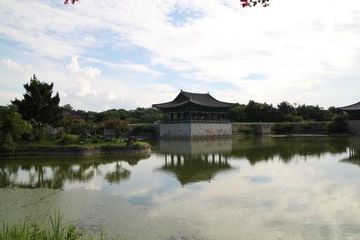경주 동궁과 월지
| 경주 동궁과 월지 Donggung Palace and Wolji Pond, Gyeongju |
|
 경주 동궁과 월지, 국가문화유산포털, 문화재청. |
|
| 대표명칭 | 경주 동궁과 월지 |
|---|---|
| 영문명칭 | Donggung Palace and Wolji Pond, Gyeongju |
| 한자 | 慶州 東宮과 月池 |
| 주소 | 경상북도 경주시 인왕동 원화로 102 |
| 지정(등록) 종목 | 사적 제18호 |
| 지정(등록)일 | 1963년 1월 21일 |
| 분류 | 유적건조물/정치국방/궁궐·관아/궁궐터 |
| 시대 | 통일신라 |
| 수량/면적 | 350,042㎡ |
| 웹사이트 | 경주 동궁과 월지, 국가문화유산포털, 문화재청. |
|
|
|
해설문
국문
월성 옆에 만들어진 신라의 궁궐터이다. 동궁은 동쪽 궁궐이란 뜻이지만, 태자나 세자를 일컫는 말이자 그들이 거처하는 궁 자체를 의미하기도 한다.
『삼국사기』에는 문무왕 14년(674) 왕궁의 정원이자 휴식처인 연못을 파고 그 안에 인공산을 조성하여 진귀한 동식물을 길렀고, 5년 뒤 연못 부근에 동궁을 조성하였다고 한다. 조선시대 기록에는 이 연못을 안압지(雁鴨池)라 하였다. 월지 서쪽의 임해전(臨海殿)은 동궁의 중심 건물로 귀빈의 접대나 큰 연회를 열었고, 신라 마지막 왕인 경순왕이 고려 태조 왕건을 이곳에서 맞이하여 잔치를 베풀기도 하였다.
1974년 월지와 주변에 대한 발굴조사에서 연못 서쪽과 남쪽에서 건물터 26곳, 담장터 8곳, 배수로 시설 2곳, 입수구 1곳이 확인되었으며, 3만 여점에 달하는 많은 유물이 출토되었다. 특히 동궁 안의 생활 모습을 유추할 수 있는 생활 필수품과 목간(木簡)*을 비롯한 문자 자료들이 많이 출토되어 큰 관심을 끌었다. 연못 동편에서도 대규모 건물지들이 확인됨에 따라 신라 동궁은 월지를 중심으로 동, 서, 남쪽의 건물들을 포괄하는 대규모 궁궐이었음을 알 수 있다.
- 목간(木簡) : 종이가 발명되기 이전에 죽간(竹簡)과 함께 문자 기록을 위해 사용하던 목편(木片).
영문
Donggung Palace and Wolji Pond, Gyeongju
This is the site of a royal palace and an artificial lotus pond built in the late 7th century during the Unified Silla period (668-935).
This pond and palace were built to the northeast of the main palace named Wolseong. It is said that the pond had artificial islands and miniature peaks made of stone, and beautiful flowers and trees were planted and exotic birds and animals were raised around the pond. The palace built around the pond was used to hold banquets on special occasions. The palace’s main building was called Imhaejeon, meaning “Hall on the Seaside,” suggesting that this pond symbolized the ocean.
In the mid-1970s, excavations of the site were conducted, revealing well-intact pond embankments, water drainage structures, and 26 building sites. In 1980, the remaining pavilion, three of the five building sites to the west of the pond, and the pond itself were reconstructed. Artifacts excavated from the site include a gilt-bronze Buddhist statue, gilt-bronze ornaments, parts of wooden buildings, and unique roof tiles.
This area had been called Anapji, meaning “Pond of the Goose and Duck,” since the early period of the Joseon dynasty (1392-1910). However, during the reconstruction of the site, shards of Silla-period earthenware were found here which showed that the pond was originally named Wolji, meaning “Pond of the Moon.”
- After the end of the Silla kingdom, the area became abandoned, and by the Joseon period (1392-1910) only one pavilion remained standing next to the pond, presumably reconstructed at some later time. During the Japanese colonial period (1910-1945), the vicinity was significantly damaged when a railway and road were constructed to the north and south of the site. In the mid-1970s, excavations of the site were conducted, revealing well-intact pond embankments, water drainage structures, and 24 building sites. In 1980, the remaining pavilion, three of the five building sites to the west of the pond, and the pond itself were reconstructed. Artifacts excavated from the site include a gilt-bronze Buddhist statue, gilt-bronze ornaments, parts of wooden buildings, and unique roof tiles. Large bowls and plates, which are unlike those excavated from tombs, were found, thus showing that burial goods and everyday goods were different. Further excavations took place from 2007 to ????.
- 민백 - 『삼국사기(三國史記)』에는 674년(문무왕 14)에 건립하였다고 하지만,『동경잡기(東京雜記)』에는 안압지가 건립된 시기와 비슷하거나 그보다 뒤에 만들어졌다고 하였다. + 특히 기와에는 679년인 ‘의봉4년(儀鳳四年)’이라는 글자가 새겨져 있었는데, 이것은 임해전터에서 출토된 680년인 ‘조로2년(調露二年)’이라는 글자가 새겨진 보상화(寶相華) 무늬의 벽돌과 함께 문무왕 때 임해전이 건립되었음을 알려주는 대표적인 유물로 여겨진다.
- 인근 차도도 일제 강점기에 만든 건지 해방이후인지?*표시된 내용 재검토 필요.
- ‘동궁’이라는 명칭도 월지와 지슷하게 유물로 확인 된 것닝지?